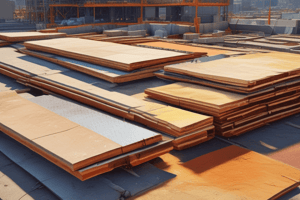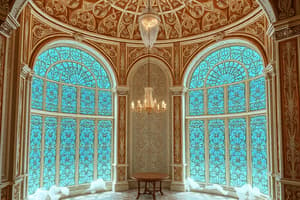Podcast
Questions and Answers
What is one key attribute of wood slats that makes them popular for furniture and outdoor use?
What is one key attribute of wood slats that makes them popular for furniture and outdoor use?
- Natural beauty and strength (correct)
- Weather resistance
- Lightweight nature
- Cost-effectiveness
Which material offers durability and resistance to weather elements for architectural applications?
Which material offers durability and resistance to weather elements for architectural applications?
- Wood
- Metal (correct)
- Composite
- Plastic
What characteristic affects the strength and flexibility of plastic slats?
What characteristic affects the strength and flexibility of plastic slats?
- Manufacturing method
- Width and thickness
- Color and texture
- Type of plastic used (correct)
Which type of slat is most likely to be used in industrial applications like conveying systems?
Which type of slat is most likely to be used in industrial applications like conveying systems?
How do the dimensions and profile of a slat affect its usability?
How do the dimensions and profile of a slat affect its usability?
What is a key advantage of composite slats compared to traditional wood slats?
What is a key advantage of composite slats compared to traditional wood slats?
Which option best describes a typical manufacturing process for metal slats?
Which option best describes a typical manufacturing process for metal slats?
What aspect of slat dimensions varies widely depending on its specific application?
What aspect of slat dimensions varies widely depending on its specific application?
Flashcards
What is a slat?
What is a slat?
A thin, narrow piece of material, often used for structural support or to create a pattern or texture.
What are Wood Slats?
What are Wood Slats?
Wood slats offer natural beauty and strength. Common applications include furniture, decking, and fencing.
What are Metal Slats?
What are Metal Slats?
Metal slats are durable, strong, and weather resistant. Their common uses include roofing, ventilation, and interior dividers.
What are Plastic Slats?
What are Plastic Slats?
Signup and view all the flashcards
What are Composite Slats?
What are Composite Slats?
Signup and view all the flashcards
What is a Slat's Profile?
What is a Slat's Profile?
Signup and view all the flashcards
How are Slats Manufactured?
How are Slats Manufactured?
Signup and view all the flashcards
What are examples of Slat Applications?
What are examples of Slat Applications?
Signup and view all the flashcards
Study Notes
Introduction to Slat
- A slat is a thin, narrow piece of material, often used for structural support or to create a pattern or texture.
- Slats can be made from various materials, including wood, metal, plastic, or composites.
- The specific properties and applications of a slat depend heavily on the material from which it is made.
Types of Slats and Their Uses
- Wood Slats: Commonly used in furniture (like beds, shelves, and dividers), outdoor decking, and fencing. Their natural beauty and strength are key attributes. Different wood types may affect durability and aesthetic appeal.
- Metal Slats: Used extensively in architectural applications, often for roofing, ventilation, and interior dividers. Metal slats offer durability, strength, and resistance to weather elements. Specific types of metal (like aluminum, steel, or copper) will affect properties like corrosion resistance and conductivity.
- Plastic Slats: Commonly seen in outdoor structures, furniture, and signage. Their weather resistance, lightweight nature, and cost-effectiveness make them appealing for specific uses. Various plastic types will affect their strength, flexibility, or UV resistance.
- Composite Slats: Combining materials, like wood fiber and resin, these often mimic the look and feel of wood with enhanced durability and resistance to rot and decay. These can be ideal for demanding environments and mimic other materials.
Dimensions and Specifications
- Slat dimensions vary widely, depending on the application. Common parameters include width, thickness, and length.
- The slat's profile (e.g., square, rectangular, or curved) also affects its usability.
- The tolerance for variation in dimensions is also relevant to the end product use-case.
Manufacturing Processes
- The manufacturing methods for slats vary depending on the material. Wood slats might be sawn or planed, while metal slats are often formed or extruded.
- Specific manufacturing processes can affect the slat's final quality, appearance, and performance characteristics.
Applications of Slats
- Furnishings: Beds, shelves, dividers, and window coverings are common applications for slatted designs.
- Architecture: Roofing, cladding, ventilation systems, and interior partitions use slatted structures.
- Outdoor Structures: Decking, fencing, and siding frequently incorporate slats.
- Industrial: Conveying systems, support structures, or storage systems may use slats.
- Agricultural: Slats can be used in animal housing or for temporary structures in farming.
Advantages and Disadvantages
- Advantages include ease of installation, varied aesthetic options, good structural support (in some cases), cost-effectiveness (for some materials).
- Disadvantages include potential susceptibility to damage (depending on the material), difficulty in achieving perfect uniformity.
Maintenance and Durability
- The maintenance required for slats depends strongly on their material.
- Materials like wood might require regular sealing and staining to prevent decay and weathering.
- Metal slats often require protection to prevent rust or other corrosion.
- Durability is also affected by factors like UV exposure or environmental elements.
Studying That Suits You
Use AI to generate personalized quizzes and flashcards to suit your learning preferences.
Description
This quiz covers the fundamentals of slats, which are thin, narrow materials used for support and aesthetics in various applications. Explore the different types of slats, including wood, metal, and plastic, and their respective uses in furniture, architecture, and outdoor structures.





